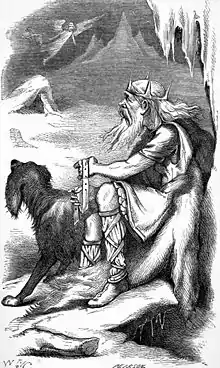
In Norse mythology, Þrymr (Thrymr, Thrym; "noise"[1][2]) was a jötunn. He is the namesake of the Eddic poem Þrymskviða, in which he stole Thor's hammer Mjǫlnir. An early king of the same name is mentioned in Hversu Noregr byggðist.
Þrymskviða
Through Loki, Þrymr conveys his demand for the goddess Freyja's hand in marriage as the price for returning Mjǫlnir, which he has buried eight leagues under the ground. When Loki flies to Jǫtunheimar using Freyja's feather cloak, he finds Þrymr sitting on a mound, twisting gold leashes for his dogs, and primping his horses' manes. He is repeatedly described as þursa dróttinn ("lord of thurses"). To recover his hammer, Thor travels to Jǫtunheimar disguised as Freyja, in bridal drag; when Þrymr peeps under "her" veil, seeking a kiss from his bride, Thor's glare sends him reeling the length of the hall.[3] Nonetheless, Þrymr is stupid enough to believe the explanations of "Freyja's handmaiden", Loki.[4][5] Thor regains his weapon when Þrymr has it brought out and laid in Thor's lap to bless their union, and strikes Þrymr dead first, followed by all his assembled kin and following.
The only other mention of Þrymr is in the þulur appended to the Prose Edda, probably deriving from Þrymskviða.[1][2]
Hversu Noregr byggðist
Among early rulers of Norway, a Þrymr is mentioned as ruling Agder and having sons named Agði and Agnarr.[6]
References
- 1 2 Rudolf Simek, trans. Angela Hall, Dictionary of Northern Mythology, Cambridge: D. S. Brewer, 1993, repr. 2000, p. 330.
- 1 2 John McKinnell, "Myth as Therapy: The Usefulness of Þrymskviða", Medium Ævum 69.1 (2000) 1–20, p. 19, note 62.
- ↑ An example of the ferocity of Thor's gaze; Jan de Vries,Altgermanische Religionsgeschichte, 2 vols., Volume 2, 2nd ed. Berlin: De Gruyter, 1957, repr. as 3rd ed. 1970, p. 122 (in German).
- ↑ John Lindow, Norse Mythology: A Guide to the Gods, Heroes, Rituals, and Beliefs, Oxford: Oxford University, 2001, repr. 2002, p. 295.
- ↑ McKinnell, p. 4, describes him as "aggressive, stupid, and bombastic throughout".
- ↑ Hversu Noregr byggðist at Heimskringla.no, from Fornaldarsögur Norðurlanda, Volume 2, ed. Guðni Jónsson, 1943–44.